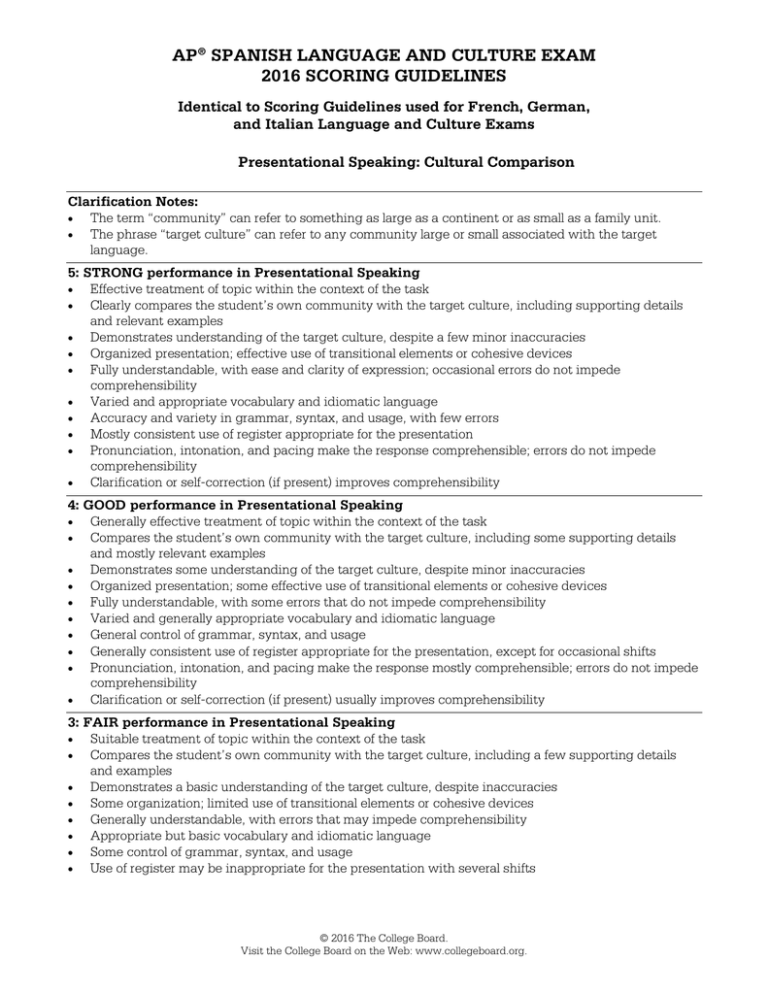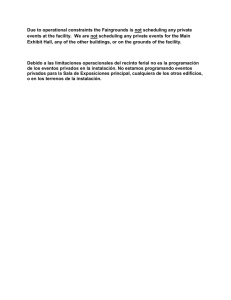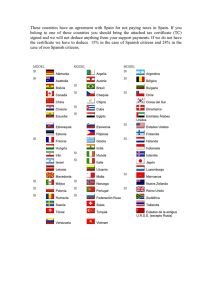AP Spanish Language and Culture Student Sample
Anuncio

AP® SPANISH LANGUAGE AND CULTURE EXAM 2016 SCORING GUIDELINES Identical to Scoring Guidelines used for French, German, and Italian Language and Culture Exams Presentational Speaking: Cultural Comparison Clarification Notes: • The term “community” can refer to something as large as a continent or as small as a family unit. • The phrase “target culture” can refer to any community large or small associated with the target language. 5: STRONG performance in Presentational Speaking • Effective treatment of topic within the context of the task • Clearly compares the student’s own community with the target culture, including supporting details and relevant examples • Demonstrates understanding of the target culture, despite a few minor inaccuracies • Organized presentation; effective use of transitional elements or cohesive devices • Fully understandable, with ease and clarity of expression; occasional errors do not impede comprehensibility • Varied and appropriate vocabulary and idiomatic language • Accuracy and variety in grammar, syntax, and usage, with few errors • Mostly consistent use of register appropriate for the presentation • Pronunciation, intonation, and pacing make the response comprehensible; errors do not impede comprehensibility • Clarification or self-correction (if present) improves comprehensibility 4: GOOD performance in Presentational Speaking • Generally effective treatment of topic within the context of the task • Compares the student’s own community with the target culture, including some supporting details and mostly relevant examples • Demonstrates some understanding of the target culture, despite minor inaccuracies • Organized presentation; some effective use of transitional elements or cohesive devices • Fully understandable, with some errors that do not impede comprehensibility • Varied and generally appropriate vocabulary and idiomatic language • General control of grammar, syntax, and usage • Generally consistent use of register appropriate for the presentation, except for occasional shifts • Pronunciation, intonation, and pacing make the response mostly comprehensible; errors do not impede comprehensibility • Clarification or self-correction (if present) usually improves comprehensibility 3: FAIR performance in Presentational Speaking • Suitable treatment of topic within the context of the task • Compares the student’s own community with the target culture, including a few supporting details and examples • Demonstrates a basic understanding of the target culture, despite inaccuracies • Some organization; limited use of transitional elements or cohesive devices • Generally understandable, with errors that may impede comprehensibility • Appropriate but basic vocabulary and idiomatic language • Some control of grammar, syntax, and usage • Use of register may be inappropriate for the presentation with several shifts © 2016 The College Board. Visit the College Board on the Web: www.collegeboard.org. AP® SPANISH LANGUAGE AND CULTURE EXAM 2016 SCORING GUIDELINES Identical to Scoring Guidelines used for French, German, and Italian Language and Culture Exams • • Pronunciation, intonation, and pacing make the response generally comprehensible; errors occasionally impede comprehensibility Clarification or self-correction (if present) sometimes improves comprehensibility 2: WEAK performance in Presentational Speaking • Unsuitable treatment of topic within the context of the task • Presents information about the student’s own community and the target culture, but may not compare them; consists mostly of statements with no development • Demonstrates a limited understanding of the target culture; may include several inaccuracies • Limited organization; ineffective use of transitional elements or cohesive devices • Partially understandable, with errors that force interpretation and cause confusion for the listener • Limited vocabulary and idiomatic language • Limited control of grammar, syntax, and usage • Use of register is generally inappropriate for the presentation • Pronunciation, intonation, and pacing make the response difficult to comprehend at times; errors impede comprehensibility • Clarification or self-correction (if present) usually does not improve comprehensibility 1: POOR performance in Presentational Speaking • Almost no treatment of topic within the context of the task • Presents information only about the student’s own community or only about the target culture, and may not include examples • Demonstrates minimal understanding of the target culture; generally inaccurate • Little or no organization; absence of transitional elements and cohesive devices • Barely understandable, with frequent or significant errors that impede comprehensibility • Very few vocabulary resources • Little or no control of grammar, syntax, and usage • Minimal or no attention to register • Pronunciation, intonation, and pacing make the response difficult to comprehend; errors impede comprehensibility • Clarification or self-correction (if present) does not improve comprehensibility 0: UNACCEPTABLE performance in Presentational Speaking • Mere restatement of language from the prompt • Clearly does not respond to the prompt; completely irrelevant to the topic • “I don’t know,” “I don’t understand,” or equivalent in any language • Not in the language of the exam - (hyphen): BLANK (no response although recording equipment is functioning) © 2016 The College Board. Visit the College Board on the Web: www.collegeboard.org. AP® SPANISH LANGUAGE AND CULTURE 2016 SCORING COMMENTARY Task 4: Cultural Comparison Note: Student samples are quoted verbatim and may contain grammatical errors. In the transcripts of students’ speech quoted in the commentaries, a three dot ellipsis indicates that the sample has been excerpted. Two dots indicate that the student paused while speaking. Overview This task assessed speaking in the presentational communicative mode by having students make a comparative oral presentation on a cultural topic. Students were allotted 4 minutes to read the topic and prepare the presentation and then 2 minutes to deliver the presentation. The response received a single, holistic score based on how well it accomplished the assigned task. The presentation needed to compare the student’s own community to an area of the Spanish-speaking world, demonstrating understanding of cultural features of the Spanish-speaking world. Furthermore the presentation had to be organized clearly. “¿Qué tipo de eventos o actividades se consideran una expresión de la identidad cultural en tu comunidad?” was this year’s topic. To complete this task the students were required to demonstrate their understanding of the cultural features of the Spanish-speaking world. The question focused on two parts: the first asked about what types of events or activities are an expression of cultural identify and the second asked students to compare their observations — through their own studies or personal experiences — about their home communities with those of a region in the Spanish-speaking world. (¿Qué tipo de eventos o actividades se consideran una expresión de la identidad cultural en tu comunidad?”). Sample: 4A Score: 5 Transcription of Student Response En los Estados Unidos y en países latinoamericanos hay celebraciones que demuestran la identidad cultural de la comunidad .. de los dos comunidades. En mi comunidad en los Estados Unidos la día de independencia enseña nuestra identidad y orgullo de ser de los Estados Unidos. Siempre llevamos ropa de colores rojo, y .. ah .. blanco y azul para representar la bandera de los Estados Unidos. En .. um .. Chile, el rodeo chileno enseña.. um la identidad cultura .. ah porque en el rodeo los huasos llevan ropa tradicional de Chile y .. um en ese evento comen comida tradicional. Y también en los Estados Unidos .. um en el festival cuando el pelota cae el día antes de el nuevo año demuestra nuestra .. ah .. identidad cultural porque es algo muy .. um americano de los Estados Unidos y en Cuba, la Nochebuena es una celebración que demuestra la identidad cultural porque .. ah allí comen comida tradicional como el lechón y demuestra su cultura. Ah .. y también .. ah toman mucho tiempo con su familia y es algo muy importante para su cultura también. Y.. um .. um .. en resumen, .. um en los Estados Unidos y en países latinoamericanos como en Chile y Cuba um hay celebraciones y eventos para celebrar la identidad cultural como la día de independencia, el día antes del Nuevo Año en los Estados Unidos, el rodeo chileno y la Nochebuena en Cuba. Commentary This is a sample of a strong performance in presentational speaking. The organization is excellent. The student has an introduction “En los Estados Unidos y en países latinoamericanos hay celebraciones que demuestran la identidad cultural de la comunidad .. de los dos comunidades” and a conclusion “en resumen .. um en los Estados Unidos y en países latinoamericanos como en Chile y Cuba um hay celebraciones y eventos para celebrar la identidad cultural” and clearly compares their culture with two other countries. The student demonstrates a good understanding of the target cultures: “comen comida tradicional como el lechón y demuestra su cultura.” There is appropriate and varied vocabulary in spite of some repetition of phrases like “identidad cultural” and “demuestra.” There is accuracy in grammatical © 2016 The College Board. Visit the College Board on the Web: www.collegeboard.org. AP® SPANISH LANGUAGE AND CULTURE 2016 SCORING COMMENTARY Task 4: Cultural Comparison (continued) structures. There are transitional expressions such as “también” and “en resumen.” This sample is fully understandable with ease and clarity of expression. Sample: 4B Score: 3 Transcription of Student Response Ah .. compararé .. ah .. los los eventos y actividades me consideran una expresión de la identidad cultural en mi comunidad y en los países hispanohablantes. Primero, en los dos países, los deportes son muy importante .. ah .. para expresar la identidad cultural. En España el deporte fútbol es muy importante para muchos personas y .. este deporte unir .. a los personas de la comunidad porque .. ah .. tiene mucho, mucho .. divertido aquí. Y también aquí en mi comunidad .. ah .. los .. ah .. deportes eventos de mi escuela como los ah .. partidos de baloncesto o fútbol .. Um, un otro evento en los países hispanohablantes, en específicamente en México, es Día de los Muertos. Ah .. este es muy importante para la identidad cultural. Es ah .. donde puedes expresarte y hacer un buen tiempo con la familia y donde puedes .. um hacer actividades que relatar a la cultura de tu país. Um .. un otro even .. actividad que me consideran una expresión de la identidad cultural es el tipo de baile. El tipo de baile es .. ah .. muy diferente en todos países y yo pienso que este expresar ah .. la identidad cultural. Y .. sí.. Mu .. muchas gracias. Commentary This sample reflects a fair performance in presentational speaking. It is a suitable treatment of the topic with a comparison of two cultures. The student presents information on two cultures, but does not develop or elaborate their responses with supporting details: “Y también aquí en mi comunidad .. ah .. los .. ah .. deportes eventos de mi escuela como los ah .. partidos de baloncesto o fútbol.” The student demonstrates a basic understanding of the target culture related to sports and dances. There is some control of grammar, although the student on occasion does not conjugate the verbs “relatar” and “expresar.” The vocabulary is basic but appropriate: “deportes”; “divertido”; “baile.” Pronunciation and pacing make the response generally comprehensible. Sample: 4C Score: 1 Transcription of Student Response Tipos de eventos o actividades que se consideran una expresión de la identidad cultural en mi comunidad es .. la música. Aquí hay bastantes festivales .. ah .. siempre hay bastantes conciertos y cosas así. So .. Eso siempre ha sido una cuestión no solo en .. música de lírica pero bailando y instrumentos. Y en un lugar que .. ah .. puedo comparar .. ah .. mi ciudad es Cuba, porque allá no hay mucho radio ni instrumentos pero .. tienen bastante festivales y recientemente fueron los Rolling Stones a hacer un concierto en .. creo que en .. Habana, donde había miles de personas que fueron para ver la música porque no siempre eso .. eso pasa porque .. no los dejan. Commentary This is a sample of a weak performance in presentational speaking. The task is to make a cultural comparison of the type of events or activities that the student considers as an expression of cultural identity in their community and that of the Spanish-speaking world. This sample shows limited organization since it mostly presents statements with no comparative development and lacks transitional elements. The student mentions “festivales”; “conciertos”; “la música”; “bailando”; and “instrumentos” but does not compare or elaborate. Even though two communities are mentioned, there is no comparison. © 2016 The College Board. Visit the College Board on the Web: www.collegeboard.org.




